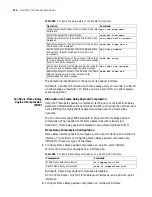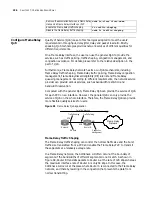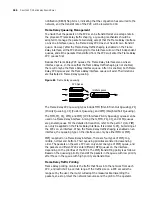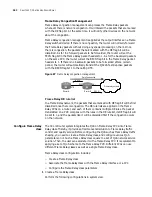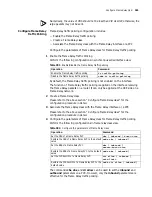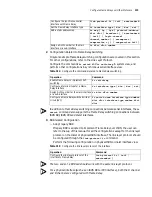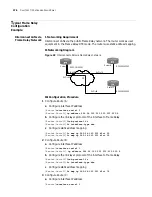
270
C
HAPTER
17: C
ONFIGURING
F
RAME
R
ELAY
After configuring the Frame Relay route through the
fr dlci-switch interface
tunnel
command, two routes will be added to the Frame Relay routing table on
the router. One route takes the tunnel interface as the incoming interface and the
serial interface as the outgoing interface. On the contrary, the other route takes
the serial interface as the incoming interface and the tunnel interface as the
outgoing interface.
After the Frame Relay route is configured through the
fr dlci-switch
interface tunnel
command, a PVC will be created on the tunnel interface and
assigned with a DLCI number
out-dlci
. When implementing configuration, make
sure that the same DLCI number (that is,
out-dlci
) should be used on the tunnel
interfaces at two ends of the GRE tunnel.
Frame Relay over ISDN
Nowadays, Frame Relay technique has gained wide applications, in which, most
devices are accessed to the Frame Relay networks via leased lines. To shorten the
time for users to access Frame Relay networks and lower the cost of leased lines,
ISDNs and the related devices can be used to access Frame Relay networks, the
so-called Frame Relay over ISDN.
With the Frame Relay over ISDN technique, the cost of a leased line can be shared
by the routers, so the overall cost is lowered. The users can access the Frame Relay
networks much quicker and with lower cost. At the same time, ISDN can also be
taken as a standby for Frame Relay accessing. Therefore, the Frame Relay over
ISDN is mainly used in the following two aspects:
■
The simplest application is to take Frame Relay over ISDN as the main
communications method. That is, all the routers support Frame Relay over
ISDN, and the individual routers can directly access the Frame Relay networks
(without TA adapters) to communicate.
■
Combined with BDR, Frame Relay over ISDN can be taken as the standby
communication method for Frame Relay. In such applications, routers support
Frame Relay over ISDN. Being the standby for a Frame Relay network, ISDN can
be used to re-establish the connections for accessing the Frame Relay network,
whenever a Frame Relay accessing line/device fails to work or the Frame Relay
network is blocked.
Frame Relay over ISDN Operation Process and Fundamentals
The following figure shows a typical networking for Frame Relay accessing, in
which all the routers support Frame Relay over ISDN:
Figure 89
Networking of a typical Frame Relay over ISDN application
RouterA, RouterB and RouterC support Frame Relay over ISDN. Being DTE devices,
they and RouterD transmit Frame Relay packets over ISDN B channels. RouterD,
which works as a DCE device, supports both Frame Relay over ISDN and Frame
Relay switching. A simplified working procedure is shown below:
■
RouterA (DTE device) originates a call on the BRI interface to the PRI interface
on RouterD (DCE device).
Frame Relay
Router B
ISDN
Router A
Frame Relay
Summary of Contents for 3036
Page 1: ...http www 3com com 3Com Router Configuration Guide Published March 2004 Part No 10014299 ...
Page 4: ...VPN 615 RELIABILITY 665 QOS 681 DIAL UP 721 ...
Page 6: ...2 ABOUT THIS GUIDE ...
Page 7: ...I GETTING STARTED Chapter 1 3Com Router Introduction Chapter 2 3Com Router User Interface ...
Page 8: ...4 ...
Page 16: ...12 CHAPTER 1 3COM ROUTER INTRODUCTION ...
Page 34: ...30 ...
Page 60: ...56 CHAPTER 3 SYSTEM MANAGEMENT ...
Page 98: ...94 CHAPTER 6 DISPLAY AND DEBUGGING TOOLS ...
Page 110: ...106 ...
Page 114: ...110 CHAPTER 8 INTERFACE CONFIGURATION OVERVIEW ...
Page 158: ...154 CHAPTER 10 CONFIGURING WAN INTERFACE ...
Page 168: ...164 ...
Page 188: ...184 CHAPTER 13 CONFIGURING PPPOE CLIENT ...
Page 192: ...188 CHAPTER 14 CONFIGURING SLIP Router ip route static 0 0 0 0 0 0 0 0 10 110 0 1 ...
Page 248: ...244 CHAPTER 16 CONFIGURING LAPB AND X 25 ...
Page 320: ...316 ...
Page 330: ...326 CHAPTER 20 CONFIGURING IP ADDRESS ...
Page 362: ...358 CHAPTER 21 CONFIGURING IP APPLICATION ...
Page 374: ...370 CHAPTER 23 CONFIGURING IP COUNT ...
Page 406: ...402 CHAPTER 25 CONFIGURING DLSW ...
Page 408: ...404 ...
Page 452: ...448 CHAPTER 29 CONFIGURING OSPF ...
Page 482: ...478 CHAPTER 30 CONFIGURING BGP ...
Page 494: ...490 CHAPTER 31 CONFIGURING IP ROUTING POLICY ...
Page 502: ...498 ...
Page 508: ...504 CHAPTER 33 IP MULTICAST ...
Page 514: ...510 CHAPTER 34 CONFIGURING IGMP ...
Page 526: ...522 CHAPTER 36 CONFIGURING PIM SM ...
Page 528: ...524 ...
Page 532: ...528 CHAPTER 37 CONFIGURING TERMINAL ACCESS SECURITY ...
Page 550: ...546 CHAPTER 38 CONFIGURING AAA AND RADIUS PROTOCOL ...
Page 590: ...586 CHAPTER 40 CONFIGURING IPSEC ...
Page 599: ...IX VPN Chapter 42 Configuring VPN Chapter 43 Configuring L2TP Chapter 44 Configuring GRE ...
Page 600: ...596 ...
Page 638: ...634 CHAPTER 43 CONFIGURING L2TP ...
Page 649: ...X RELIABILITY Chapter 45 Configuring a Standby Center Chapter 46 Configuring VRRP ...
Page 650: ...646 ...
Page 666: ...662 ...
Page 670: ...666 CHAPTER 47 QOS OVERVIEW ...
Page 700: ...696 CHAPTER 49 CONGESTION MANAGEMENT ...
Page 706: ...702 CHAPTER 50 CONGESTION AVOIDANCE ...
Page 707: ...XII DIAL UP Chapter 51 Configuring DCC Chapter 52 Configuring Modem ...
Page 708: ...704 ...
Page 762: ...758 CHAPTER 52 CONFIGURING MODEM ...

